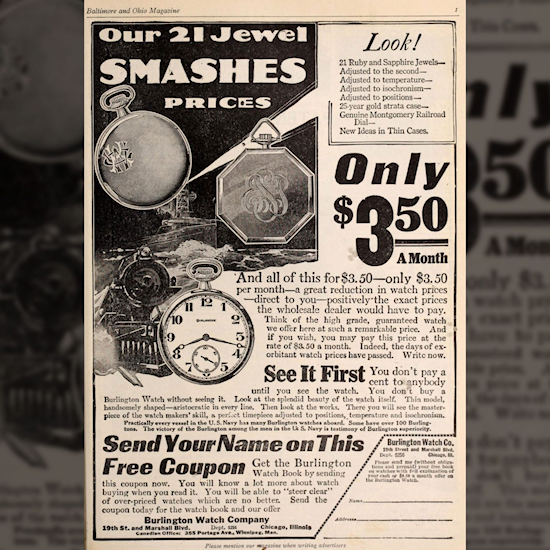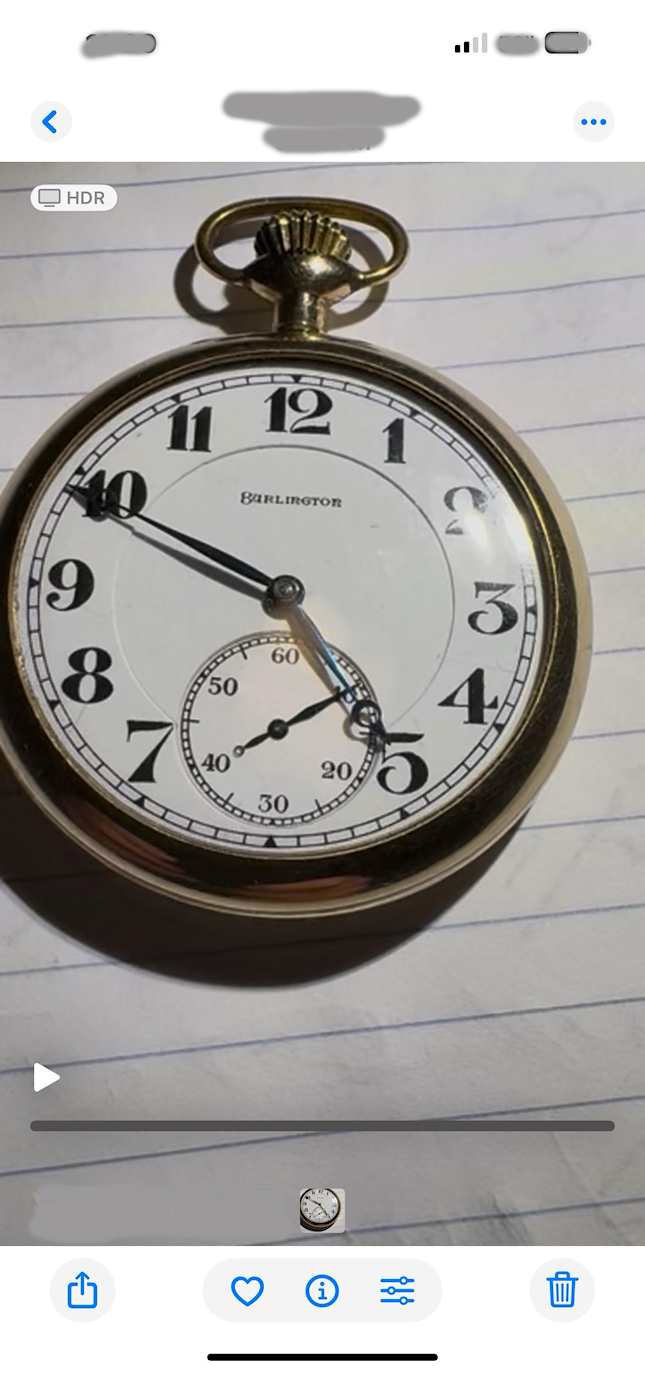
So is this a real “railroad grade” pocket watch?
Yes on certain railroads. It had three positional adjustments.
Most railroads required five positional ajustments some six depending
on the railroad and the standard at the time the pocket watch was
manufactured.
Home / Railroad Watches / Private Label Trade Names on American Pocket Watches: “Burlington Watch Co.” Part 73: Railroad Grade Classification for 16-Size Burlington Watches
Private Label Trade Names on American Pocket Watches: “Burlington Watch Co.” Part 73: Railroad Grade Classification for 16-Size Burlington Watches
“Our 21 Jewel Smashes Prices” Baltimore and Ohio Magazine, September 1920.
In contrast to the Santa Fe Watch Company that sold watches with identical traits, the Burlington Watch Company never directly promoted the Burlington watch for railroad service in the United States.
The majority of 16-Size movements manufactured by the Illinois Watch Company for Burlington were factory-adjusted to three positions, falling short of the five positional adjustments required by most American railroads at the time. On a small number of railroads, like the Santa Fe, where only three positional adjustments were required, the 16-Size Burlington would have qualified for railroad service.
While never directly stating the watches were intended for railroad service, the Burlington Watch Company often published testimonials from railroad men to suggest the quality was comparable to a railroad grade watch.
Some advertisements featured illustrations of locomotives, and the company even promoted the Burlington watch in railroad industry publications like the Brotherhood of Locomotive Firemen and Enginemen’s magazine.
However, the only watch sold by the Burlington Watch Company that broadly qualified for railroad service in the United States was the limited-run Sangamo Burlington, adjusted to six positions.
The validity of a “railroad grade” classification is frequently questioned when discussing the Santa Fe Special 16-Size watches sold by the Santa Fe Watch Company. While some point to the acceptance into service on the Santa Fe Railroad to support a railroad grade label, others argue that the watch would not have been accepted on most lines throughout the United States, requiring five positional adjustments.
Both arguments are valid. This is where the subtle nuances of the “railroad grade” classification become apparent.
Despite the desire for a clear distinction, every railroad maintained its own specifications for watches accepted into service, usually determined by the General Time Inspector.
These requirements also changed over time, so a watch approved for railroad service in 1890 may not have qualified in 1910.
Due to the nature of how the time inspection system was developed and controlled, the requirements on many railroads generally became aligned. However, there were always outliers.
One such outlier was the Atchison, Topeka, and Santa Fe Railroad, requiring only three positional adjustments instead of the five specified by most railroads at the time.
So, was the Santa Fe Special a railroad watch?
Yes – As long as we are within the proper context of lines like the Santa Fe Railroad that only required three positional adjustments.
Once we expand the conversation to general approval, then no, the Santa Fe Special would not have been widely accepted on most railroads.
The nuances with railroad grade classifications deserve more delicate consideration rather than a black-and-white designation.
The Pocket Watch Database displays “Limited Approval” status on watches like the Santa Fe Special, signifying that some railroads would have accepted the watch into service even though it would not have been widely accepted across the country.
_______________________________________________________________________
Captain Convey Pocket Watch
https://pocketwatchdatabase.com/search/result/burlington-watch-co./3473197
Its a beauty.

Made in 1919.
Model 9.
Grade 107.
Size 16s
Jewels 21
Openface
3 adjustments.
Double Roller.
Gold cover plates – not solid gold.
Railroad Grade: Limited Approval
(Limited approval means it was accepted as a Railroad Grade
Pocket Watch on certain Railroads but not all.)
For about the first ten years, Burlington sold mostly 19-jewel watches, a large number of which were marketed as the Burlington Special. These watches used an Illinois Model 5 and Model 9 (Grades No. 106 and No. 107) movements. During this period Burlington contracted for a few 21-jewel, model 5, Sangamo grade movements, which was widely accepted for railroad time service.
In February 1917, Burlington discontinued the 19-jewel watches and introduced a complete line of 21-Jewel Watches, adjusted to temperature and positions (the number of positions was unspecified).
Perhaps the most common of the 16-size, 21-jewel Burlington watches were the Illinois-built Model 9, Grades No. 107 and No. 108.
My watch is 16-size, 21-jewel, Model 9, Grade 107.
This is the first Pocket Watch I have ever owned.
I did a lot of research about Pocket watches and found this one,
not on ebay.
From 1970-1973 I worked for A railroad company as a bridge laborer.
I Was hired at age 19. It was good money at the time but back breaking work.
Because of this my Burlington – Illinois 1919 Pocket Watch will bring
memories about the time I pounded spikes and moved large bridge
ties.
I had enough sense, by God’s grace, to quit the laborer job before it
did my back in.
Railroad grade pocket watches were made better. They had to be.
I own a piece of history.